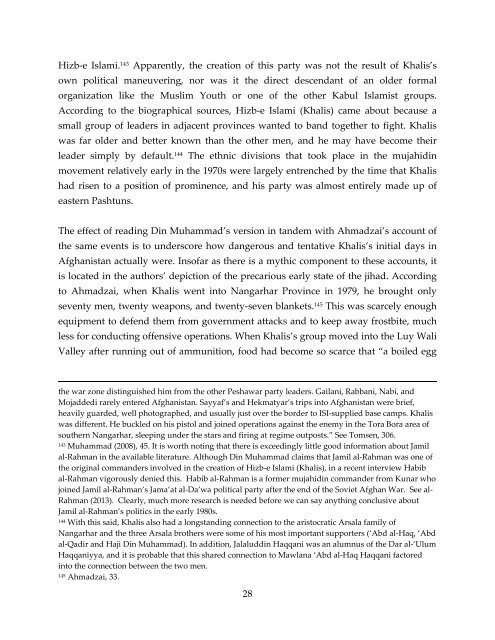Usama bin Ladin’s “Father Sheikh”:
Usama bin Ladin’s “Father Sheikh”:
Usama bin Ladin’s “Father Sheikh”:
Create successful ePaper yourself
Turn your PDF publications into a flip-book with our unique Google optimized e-Paper software.
Hizb‐e Islami. 143 Apparently, the creation of this party was not the result of Khalis’s<br />
own political maneuvering, nor was it the direct descendant of an older formal<br />
organization like the Muslim Youth or one of the other Kabul Islamist groups.<br />
According to the biographical sources, Hizb‐e Islami (Khalis) came about because a<br />
small group of leaders in adjacent provinces wanted to band together to fight. Khalis<br />
was far older and better known than the other men, and he may have become their<br />
leader simply by default. 144 The ethnic divisions that took place in the mujahidin<br />
movement relatively early in the 1970s were largely entrenched by the time that Khalis<br />
had risen to a position of prominence, and his party was almost entirely made up of<br />
eastern Pashtuns.<br />
The effect of reading Din Muhammad’s version in tandem with Ahmadzai’s account of<br />
the same events is to underscore how dangerous and tentative Khalis’s initial days in<br />
Afghanistan actually were. Insofar as there is a mythic component to these accounts, it<br />
is located in the authors’ depiction of the precarious early state of the jihad. According<br />
to Ahmadzai, when Khalis went into Nangarhar Province in 1979, he brought only<br />
seventy men, twenty weapons, and twenty‐seven blankets. 145 This was scarcely enough<br />
equipment to defend them from government attacks and to keep away frostbite, much<br />
less for conducting offensive operations. When Khalis’s group moved into the Luy Wali<br />
Valley after running out of ammunition, food had become so scarce that “a boiled egg<br />
the war zone distinguished him from the other Peshawar party leaders. Gailani, Rabbani, Nabi, and<br />
Mojaddedi rarely entered Afghanistan. Sayyaf’s and Hekmatyar’s trips into Afghanistan were brief,<br />
heavily guarded, well photographed, and usually just over the border to ISI‐supplied base camps. Khalis<br />
was different. He buckled on his pistol and joined operations against the enemy in the Tora Bora area of<br />
southern Nangarhar, sleeping under the stars and firing at regime outposts.” See Tomsen, 306.<br />
143 Muhammad (2008), 45. It is worth noting that there is exceedingly little good information about Jamil<br />
al‐Rahman in the available literature. Although Din Muhammad claims that Jamil al‐Rahman was one of<br />
the original commanders involved in the creation of Hizb‐e Islami (Khalis), in a recent interview Habib<br />
al‐Rahman vigorously denied this. Habib al‐Rahman is a former mujahidin commander from Kunar who<br />
joined Jamil al‐Rahman’s Jama’at al‐Da’wa political party after the end of the Soviet Afghan War. See al‐<br />
Rahman (2013). Clearly, much more research is needed before we can say anything conclusive about<br />
Jamil al‐Rahman’s politics in the early 1980s.<br />
144 With this said, Khalis also had a longstanding connection to the aristocratic Arsala family of<br />
Nangarhar and the three Arsala brothers were some of his most important supporters (‘Abd al‐Haq, ‘Abd<br />
al‐Qadir and Haji Din Muhammad). In addition, Jalaluddin Haqqani was an alumnus of the Dar al‐‘Ulum<br />
Haqqaniyya, and it is probable that this shared connection to Mawlana ‘Abd al‐Haq Haqqani factored<br />
into the connection between the two men.<br />
145 Ahmadzai, 33.<br />
28


